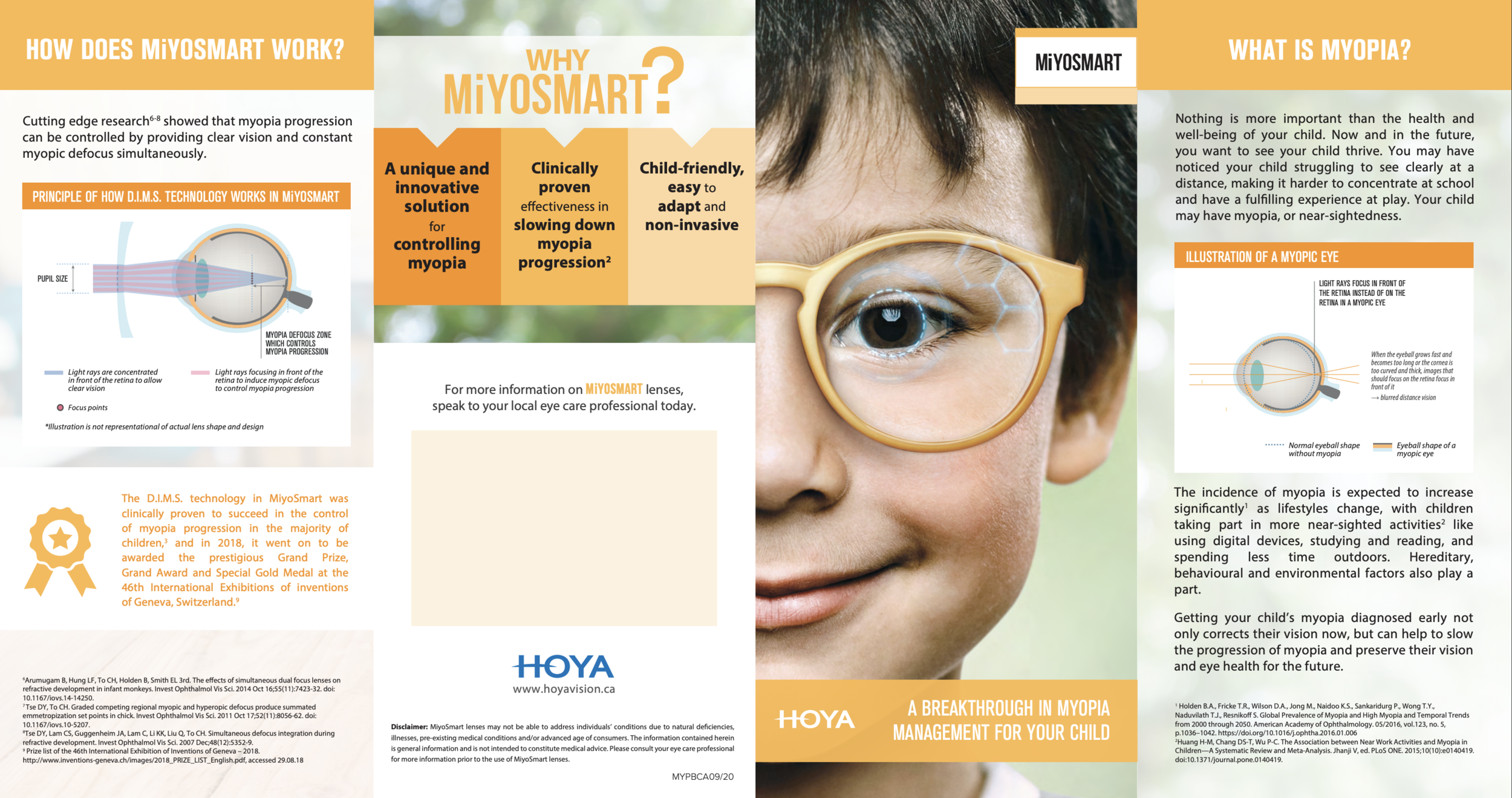Miyosmart - New Technology in Lens Design
MiYOSMART FREQUENTLY ASKED QUESTIONS
What is MiyoSmart?
MiyoSmart is a spectacle lens design that uses D.I.M.S. technology for myopia control which was developed by Hoya in partnership with The Hong Kong Polytechnic University. In 2018, the MiyoSmart lens with D.I.M.S. technology was awarded the prestigious Grand Prize, Grand Award and Gold Medal at the 46th International Exhibition of Inventions of Geneva, Switzerland.
What is D.I.M.S technology?
D.I.M.S stands for Defocus Incorporated Multiple Segments. It is the basis of Hoya’s myopia control lenses, known as MiyoSmart. The lens is comprised of a central optical zone for correcting refractive error and multiple defocus segments evenly surrounding the central zone (extending to the midperiphery) of the lens to control myopia progression. This provides clear vision and myopic defocus simultaneously at all viewing distances.
How does it work to slow down myopia?
The lens makes use of the natural homeostatic mechanism known as “emmetropisation”, whereby the eyeball adapts and shapes to receive focused images as it does for normal vision. Creating a myopic defocus (bringing rays in front of the retina) as with MiyoSmart lenses, prevents eyeball (axial length) elongation which is linked to myopia progression.
What are the main benefits of MiyoSmart?
MiyoSmart is a safe and non-invasive option for slowing myopia progression. The wearer receives correction of his/her refractive error while his/her myopic progression is slowed down. MiyoSmart also allows the wearer to move around with ease, as the lenses are impact-resistant. The lens is aesthetically pleasing with its smooth surface and near-identical appearance to single vision lenses. A clinical study concluded that MiyoSmart with DIMS Technology had myopia progression reduced by an average of 60%.
Have the effects of MiyoSmart been clinically proven?
Yes. Beyond correcting myopic refractive error, a two-year clinical trial started in 2014 involving 160 children aged 8-13, showed that MiyoSmart with D.I.M.S. (Defocus Incorporated Multiple Segments) technology works to curb myopic progression by up to 59%
The results of the trial also showed that the children using the MiyoSmart lens had less axial elongation by up to 60% as compared to those wearing single vision lenses.
Is it the same for Caucasian eyes?
Yes, we can extrapolate the COMET study3 showing no statistical difference between multi-ethnic groups.
Why not put the treatment everywhere on the lens?
It’s all about the clear central zone. We need to have a zone where we can read the power for verification and where it offers perfect distance vision. The 33mm treatment zone works for most children or frames will be cut out for bigger ones. The wearer would have to be in a very odd position to look outside of the zone or have to have their head turned in one direction and look totally on the opposite side, which is very odd and unusual.
What is the recommended adaptation period?
We recommend a 1 to 2 weeks adaptation period where we suggest constant wear and to avoid sports. MiyoSmart is considered to be very easy to get used to, compared to a new pair of single vision lenses.
What is the recommended age for MiyoSmart?
In general, MiyoSmart lenses are suitable for patients aged 6-18. It can be prescribed when the first sign of myopia appears and for as long as there are signs of progression. The final determination is made by the Eye Care Professional.
Can young adults drive with MiyoSmart lenses? There is no contraindication for driving with MiyoSmart.
Does the pupil size have an impact on the vision with MiyoSmart?
No negative effect has been reported related to pupil size while wearing MiyoSmart lenses.
Why is MiyoSmart only available in polycarbonate?
Polycarbonate is the best material selected for the safety and light weight properties. We can also incorporate the D.I.M.S technology easily on this material


